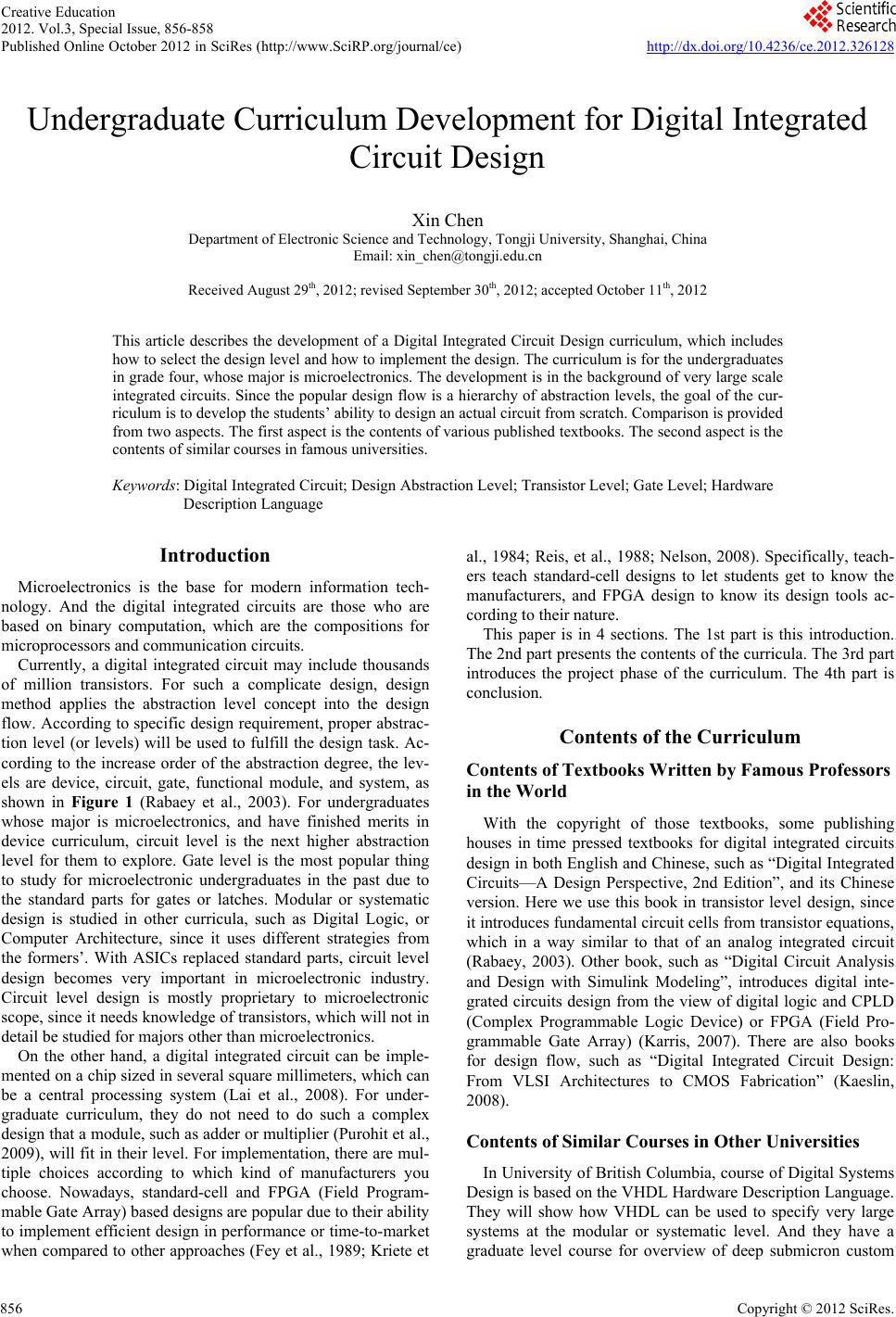
Creative Education
2012. Vol.3, Special Issue, 856-858
Published Online October 2012 in SciRes (http://www.SciRP.org/journal/ce) http://dx.doi.org/10.4236/ce.2012.326128
Copyright © 2012 SciRes.
856
Undergraduate Curriculum Development for Digital Integrated
Circuit Design
Xin Chen
Department of Electronic Science and Technology, Tongji University, Shanghai, China
Email: xin_chen@tongji.edu.cn
Received August 29th, 2012; revised September 3 0th, 2012; accepted Octob e r 11th, 2012
This article describes the development of a Digital Integrated Circuit Design curriculum, which includes
how to select the design level and how to implement the design. The curriculum is for the undergraduates
in grade four, whose major is microelectronics. The development is in the background of very large scale
integrated circuits. Since the popular design flow is a hierarchy of abstraction levels, the goal of the cur-
riculum is to develop the students’ ability to design an actual circuit from scratch. Comparison is provided
from two aspects. The first aspect is the contents of various published textbooks. The second aspect is the
contents of similar courses in famous universities.
Keywords: Digital Integrated Circuit; Design Abstraction Level; Transistor Level; Gate Level; Hardware
Description Language
Introduction
Microelectronics is the base for modern information tech-
nology. And the digital integrated circuits are those who are
based on binary computation, which are the compositions for
microprocessors and communication circuits.
Currently, a digital integrated circuit may include thousands
of million transistors. For such a complicate design, design
method applies the abstraction level concept into the design
flow. According to specific design requirement, proper abstrac-
tion level (or levels) will be used to fulfill the design task. Ac-
cording to the increase order of the abstraction degree, the lev-
els are device, circuit, gate, functional module, and system, as
shown in Figure 1 (Rabaey et al., 2003). For undergraduates
whose major is microelectronics, and have finished merits in
device curriculum, circuit level is the next higher abstraction
level for them to explore. Gate level is the most popular thing
to study for microelectronic undergraduates in the past due to
the standard parts for gates or latches. Modular or systematic
design is studied in other curricula, such as Digital Logic, or
Computer Architecture, since it uses different strategies from
the formers’. With ASICs replaced standard parts, circuit level
design becomes very important in microelectronic industry.
Circuit level design is mostly proprietary to microelectronic
scope, since it needs knowledge of transistors, which will not in
detail be studied for majors other than micro electronics.
On the other hand, a digital integrated circuit can be imple-
mented on a chip sized in several square millimeters, which can
be a central processing system (Lai et al., 2008). For under-
graduate curriculum, they do not need to do such a complex
design that a module, such as adder or multiplier (Purohit et al.,
2009), will fit in their level. For implementation, there are mul-
tiple choices according to which kind of manufacturers you
choose. Nowadays, standard-cell and FPGA (Field Program-
mable Gate Array) based designs are popular due to their ability
to implement efficient design in performance or time-to-market
when compared to other approaches (Fey et al., 1989; Kriete et
al., 1984; Reis, et al., 1988; Nelson, 2008). Specifically, teach-
ers teach standard-cell designs to let students get to know the
manufacturers, and FPGA design to know its design tools ac-
cording to their nature .
This paper is in 4 sections. The 1st part is this introduction.
The 2nd part presents the contents of the curricula. The 3rd part
introduces the project phase of the curriculum. The 4th part is
conclusion.
Contents of the Curriculum
Contents of Textbooks Written by Famous Professors
in the World
With the copyright of those textbooks, some publishing
houses in time pressed textbooks for digital integrated circuits
design in both English and Chinese, such as “Digital Integrated
Circuits—A Design Perspective, 2nd Edition”, and its Chinese
version. Here we use this book in transistor level design, since
it introduces fundamental circuit cells from transistor equations,
which in a way similar to that of an analog integrated circuit
(Rabaey, 2003). Other book, such as “Digital Circuit Analysis
and Design with Simulink Modeling”, introduces digital inte-
grated circuits design from the view of digital logic and CPLD
(Complex Programmable Logic Device) or FPGA (Field Pro-
grammable Gate Array) (Karris, 2007). There are also books
for design flow, such as “Digital Integrated Circuit Design:
From VLSI Architectures to CMOS Fabrication” (Kaeslin,
2008).
Contents of Similar Courses in Other Universities
In University of British Columbia, course of Digital Systems
Design is based on the VHDL Hardware Description Language.
They will show how VHDL can be used to specify very large
systems at the modular or systematic level. And they have a
graduate level course for overview of deep submicron custom